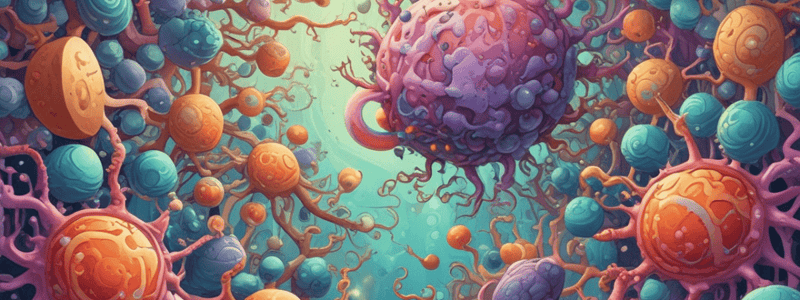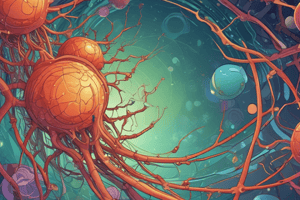Podcast
Questions and Answers
What can be compared to the immune system's function of protecting the body?
What can be compared to the immune system's function of protecting the body?
What is the primary function of the skin in the immune system?
What is the primary function of the skin in the immune system?
What type of bacteria in the gut helps to fight against bad bacteria?
What type of bacteria in the gut helps to fight against bad bacteria?
What is the pH of the stomach's environment that helps to kill bacteria?
What is the pH of the stomach's environment that helps to kill bacteria?
What is the term for the body's immediate response mechanisms to pathogens?
What is the term for the body's immediate response mechanisms to pathogens?
How many lines of defense does the immune system have?
How many lines of defense does the immune system have?
What is the primary function of the complement system in the body?
What is the primary function of the complement system in the body?
What is the main difference between innate and adaptive immunity?
What is the main difference between innate and adaptive immunity?
What is the role of CD4 helper T cells in the immune response?
What is the role of CD4 helper T cells in the immune response?
What is the term for the interaction between cells and chemical factors in the immune response?
What is the term for the interaction between cells and chemical factors in the immune response?
What is the primary function of B cells in the immune response?
What is the primary function of B cells in the immune response?
What is the term for the type of immunity that involves protein factors such as complement systems and antibodies present in the blood plasma?
What is the term for the type of immunity that involves protein factors such as complement systems and antibodies present in the blood plasma?
Flashcards are hidden until you start studying
Study Notes
Here is a summary of the text in detailed bullet points:
• The immune system can be thought of as a process of protecting the body from invaders, similar to a city's jurisdiction system, where cops and detectives find and eliminate threats to the city's peace.
• The body has various barriers to prevent pathogens from entering, including the skin, epithelial cells, mucosal layers, and normal flora (good bacteria) in the gut.
• The skin is the largest organ of the body and covers the entire body, making it the first line of defense against pathogens.
• Epithelial cells in the gut and intestine also serve as a barrier, and mucosal layers in areas like the eyes provide additional protection.
• The stomach's acidic environment (pH 2 or 3) helps to kill bacteria that enter the body through food.
• Good bacteria in the gut, known as normal flora, help to fight against bad bacteria and produce vitamin K.
• For an infection to progress, these barriers must be destroyed, and the body knows its flaws and is prepared to respond to different types of pathogens.
• The immune system has two lines of defense: innate immunity and adaptive immunity.
• Innate immunity is always present in the body and responds quickly to pathogens, consisting of cells that roam throughout the body and kill foreign substances.
• There are two types of innate defense mechanisms: always-on mechanisms, such as barriers, and immediate response mechanisms, such as complement systems.
• Barriers and complement systems are always present in the body and ready to respond to infection.
• The complement system is a group of chemical factors that target specific pathogens and create pores in bacterial cells, leading to their death.
• Adaptive immunity is a more specific response that takes longer to develop and is activated when the body encounters a pathogen.
• Adaptive immunity involves the production of specific antibodies against pathogens and is also known as delayed response.
• Lymphocytes, including T cells and B cells, are involved in adaptive immunity, with T cells helping other cells and B cells producing antibodies.
• T cells can be divided into CD4 helper T cells and CD8 killer T cells, which help other cells and kill specific targets, respectively.
• The interaction between innate and adaptive immunity is crucial, with innate immunity signaling to adaptive immunity to produce specific antibodies against pathogens.
• The immune system involves both cellular factors (cell-mediated immunity) and chemical factors (humoral immunity), including complement systems and antibodies.
• Cell-mediated immunity involves cells such as antigen-presenting cells, natural killer cells, T lymphocytes, neutrophils, and eosinophils.
• Humoral immunity, also known as antibody-mediated immunity, involves protein factors such as complement systems and antibodies present in the blood plasma.
Studying That Suits You
Use AI to generate personalized quizzes and flashcards to suit your learning preferences.




